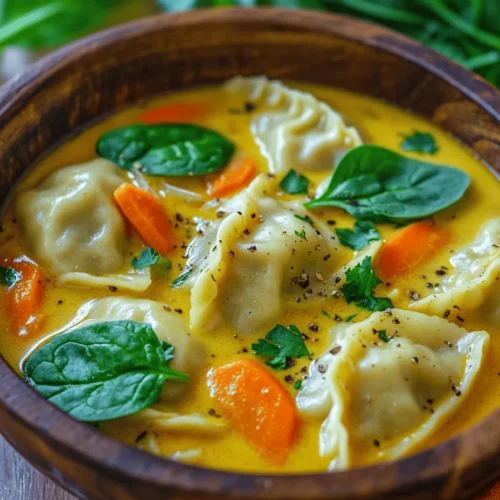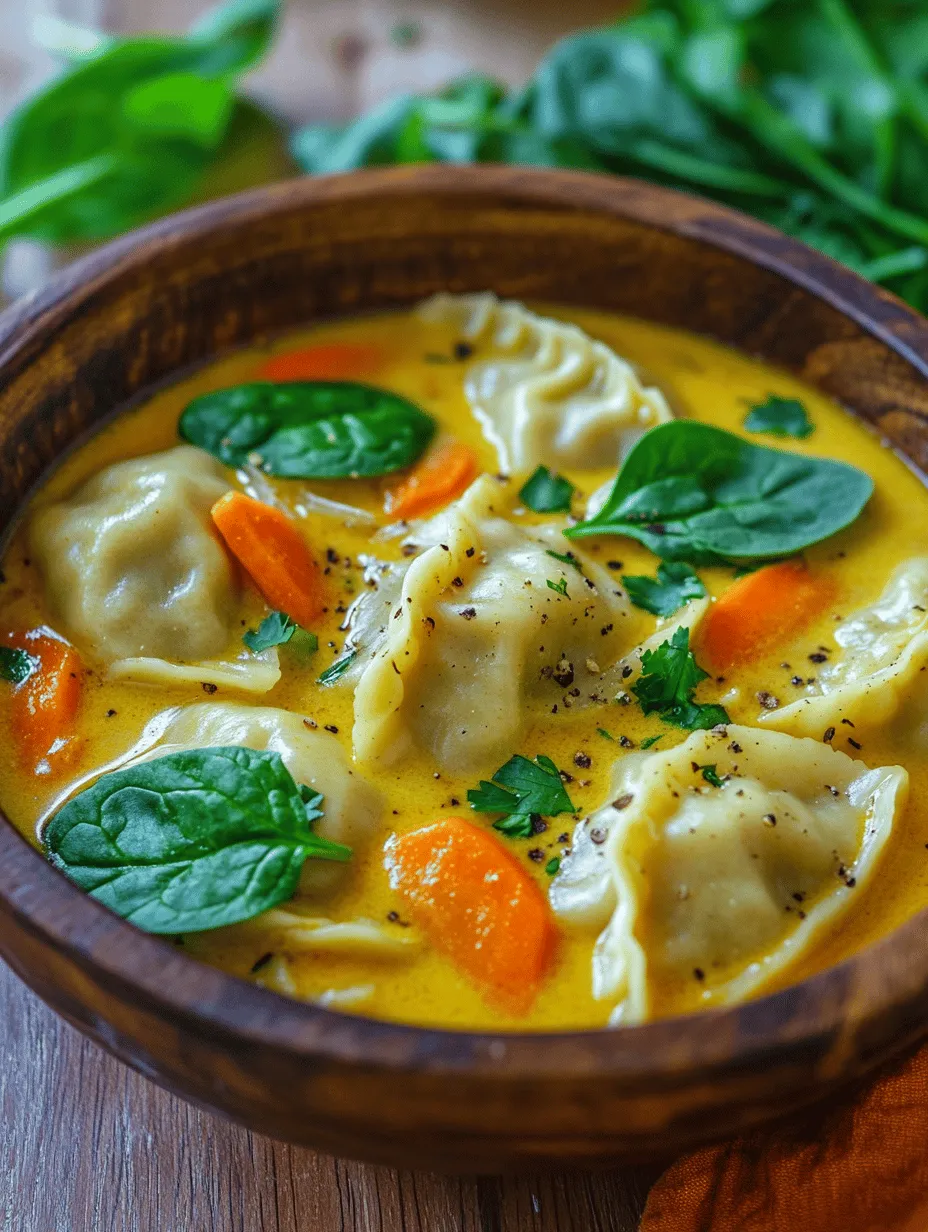Introduction to Curry Dumpling Soup: A Comforting Delight
Curry Dumpling Soup is a dish that beautifully marries the heartiness of dumplings with the vibrant and aromatic flavors of curry. Its origins can be traced back to various regions in Asia, where both dumplings and curry have been staples for centuries. From the bustling streets of India, where curry is an everyday essential, to the comforting kitchens of Southeast Asia, where dumplings are a beloved treat, this soup encapsulates a fusion of cultures and culinary traditions. The dish is not only beloved for its rich flavors but also for its ability to evoke warmth and comfort, making it perfect for any occasion, from cozy family dinners to festive gatherings.
The appeal of curry and dumplings in various cuisines lies not just in their taste but also in their versatility. Curry can range from mild to spicy, and it can be tailored to suit individual palates, while dumplings can be filled with a variety of ingredients, from meats to vegetables, catering to diverse dietary preferences. This adaptability has made curry dumpling soup a cherished recipe across continents, symbolizing comfort food in many cultures.
Moreover, this dish is not just a treat for the taste buds; it also brings a wealth of health benefits. The ingredients used in the recipe are packed with nutrients that contribute to overall well-being. For instance, ginger and garlic, both key components, are known for their anti-inflammatory and immune-boosting properties. The use of fresh vegetables not only enhances the nutritional profile of the soup but also adds texture and flavor, making every spoonful a delightful experience.
Understanding the Key Ingredients
To create the perfect curry dumpling soup, it’s essential to understand the key ingredients that contribute to its delectable taste and nutritional value.
Dumpling Ingredients
The dumplings serve as the heart of the dish, providing a chewy texture that complements the soup’s broth. Essential ingredients for the dumpling dough include:
– All-Purpose Flour: The base for the dough, it provides structure.
– Water: Necessary for hydrating the flour and creating the right consistency.
– Salt: Enhances flavor and strengthens the dough.
For the filling, creativity can run wild. Common options include:
– Ground Meat: Chicken, pork, or beef provide protein.
– Vegetables: Chopped mushrooms, carrots, and bok choy can create a refreshing vegetarian option.
– Herbs and Spices: Ingredients like cilantro, green onions, and sesame oil can add depth to the filling.
Soup Ingredients
The soup is where the magic truly happens, with its rich and aromatic broth. Key ingredients include:
– Curry Paste: Red or yellow curry paste is crucial for giving the soup its distinctive flavor. It typically contains a blend of spices, chili, garlic, lemongrass, and other aromatics.
– Coconut Milk: Adds creaminess and a subtle sweetness while balancing the spice from the curry paste.
– Vegetable or Chicken Broth: Forms the base of the soup, contributing to its depth of flavor.
– Fresh Vegetables: Spinach, carrots, and bell peppers not only add color but also provide essential vitamins and minerals.
The freshness of the ingredients plays a pivotal role in the overall flavor of the dish. Fresh ginger and garlic can elevate the taste significantly compared to their dried counterparts. Likewise, using seasonal vegetables ensures that the soup is not only delicious but also packed with nutrients.
Nutritional Benefits
Coconut milk is one of the standout ingredients in this soup, known for its healthy fats that can aid in digestion and provide energy. Spinach, a nutrient-dense leafy green, is loaded with iron, vitamins A and C, and antioxidants that are crucial for maintaining good health. Other vegetables like carrots contribute beta-carotene, while bell peppers are rich in vitamin C.
By combining these ingredients, curry dumpling soup offers a balanced meal that is hearty, satisfying, and nourishing.
Crafting the Perfect Dumplings
Dumplings are the soul of this dish, and making them from scratch can be a rewarding experience. Here’s a step-by-step guide to crafting perfect dumplings that will delight the palate.
Step 1: Make the Dumpling Dough
1. Combine Ingredients: In a mixing bowl, combine 2 cups of all-purpose flour and a pinch of salt. Gradually add water, about ¾ cup, mixing until the dough begins to come together.
2. Knead the Dough: Transfer the dough onto a clean work surface and knead for about 5-7 minutes until it becomes smooth and elastic. The key is to develop the gluten, which gives the dumplings their chewy texture.
3. Rest the Dough: Once kneaded, cover the dough with a damp cloth or plastic wrap and let it rest for at least 30 minutes. This resting period allows the gluten to relax, making it easier to roll out.
Step 2: Roll Out the Dough
After the dough has rested, it’s time to roll it out:
1. Divide the Dough: Cut the dough into manageable portions. Keep the portions you are not currently using covered to prevent them from drying out.
2. Roll Thinly: On a lightly floured surface, roll out each portion of dough as thinly as possible, aiming for a thickness of about 1/8 inch. Use a round cutter or a glass to cut out circles of dough, typically 3-4 inches in diameter.
Step 3: Fill the Dumplings
1. Prepare the Filling: While the dough rests, prepare your desired filling. For example, if using ground chicken, mix it with finely chopped garlic, ginger, green onions, and season with soy sauce and sesame oil for flavor.
2. Fill and Seal: Place a small spoonful of filling in the center of each dough circle. Be careful not to overfill, as this can make sealing difficult. Moisten the edges of the dough with a little water, fold it over, and pinch the edges together to seal tightly. You can create pleats along the edge for a decorative touch.
Tips for Optimal Texture
– Kneading: Make sure to knead the dough thoroughly for the best texture. The more you knead, the chewier the dumplings will be.
– Rolling: Roll out the dough evenly to ensure uniform cooking. Uneven thickness can lead to some dumplings being overcooked while others remain undercooked.
– Filling Variations: Don’t hesitate to experiment with different fillings. For a vegetarian option, consider using finely chopped vegetables mixed with tofu, or try a blend of seafood with herbs for a gourmet twist.
Creating the Flavorful Curry Soup
Once the dumplings are ready, the next step is to create the rich, aromatic curry soup that will elevate the dish to new heights.
Step 1: Sauté the Aromatics
1. Heat Oil: In a large pot, heat 2 tablespoons of oil over medium heat. Once hot, add chopped onions and sauté until they turn translucent, about 5 minutes.
2. Add Garlic and Ginger: Add minced garlic and ginger to the pot, stirring constantly to prevent burning. This combination of aromatics forms the foundational flavor of the soup and should be cooked until fragrant.
Step 2: Build the Flavor with Curry Paste
1. Incorporate Curry Paste: Stir in 2-3 tablespoons of red curry paste, allowing it to cook for an additional minute to release its flavors. The paste not only adds heat but also a depth of flavor that defines the soup.
Step 3: Create the Broth
1. Pour in Coconut Milk: Gradually pour in 1 can (about 400ml) of coconut milk, stirring to combine with the sautéed aromatics and curry paste. The creamy texture of coconut milk balances the spices beautifully.
2. Add Broth: Pour in 4 cups of vegetable or chicken broth, stirring well. Bring the mixture to a gentle simmer, allowing the flavors to meld.
3. Adjust Acidity: Squeeze the juice of one lime into the soup to add brightness and acidity, balancing the richness of the coconut milk and enhancing the overall flavor profile.
Step 4: Incorporate Fresh Vegetables
While the soup simmers, it’s time to add fresh vegetables that will not only contribute nutrition but also color and texture.
1. Add Vegetables: Incorporate sliced carrots, bell peppers, and a generous handful of fresh spinach into the soup. These vegetables should be added towards the end of the cooking process to retain their crispness and nutrients.
2. Simmer and Season: Allow the soup to simmer for an additional 5-10 minutes, or until the vegetables are tender but still vibrant. Taste and season with salt, pepper, or additional lime juice as desired.
This flavorful curry soup will serve as the perfect base for your dumplings, creating a harmonious blend of textures and flavors.
In this recipe, you will find that the combination of the handmade dumplings and the aromatic curry soup results in a dish that is not only comforting but also satisfying and nourishing. The next steps will guide you through assembling the soup and dumplings, ensuring that every bite is bursting with flavor.
The Importance of Color and Texture in the Dish
One of the most delightful aspects of the Best Curry Dumpling Soup is its vibrant color and rich texture, which play a crucial role in the overall eating experience. Color not only makes a dish visually appealing but also signals the variety of flavors and nutrients found within. In this soup, the golden hues of curry combined with the vivid greens of fresh vegetables create a feast for the eyes.
When preparing this dish, consider the textures as well; the tender dumplings contrasted with crisp vegetables and a silky broth create a harmonious balance. To enhance the visual appeal and nutritional value of your soup, consider seasonal vegetables that add both pops of color and crunch.
Suggestions for Seasonal Vegetable Substitutions to Enhance Freshness
Seasonal vegetables are a fantastic way to elevate your curry dumpling soup, bringing freshness and variety to the dish. Depending on the time of year, you might consider:
– Spring: Use asparagus, peas, or radishes for a crisp bite.
– Summer: Add zucchini, bell peppers, or fresh corn for sweetness and color.
– Fall: Incorporate butternut squash, carrots, or kale for a hearty feel.
– Winter: Use root vegetables like parsnips and sweet potatoes, or leafy greens like spinach or Swiss chard for warmth and flavor.
Feel free to mix and match based on what’s available at your local market or what you have in your kitchen. This adaptability not only enhances the soup but also allows you to enjoy the freshest ingredients.
Cooking Techniques for Optimal Results
Sautéing, Boiling, and Simmering for Maximum Flavor Extraction
To achieve the best flavor in your curry dumpling soup, it is essential to master several cooking techniques. Begin by sautéing your aromatics—such as onions, garlic, and ginger—in a bit of oil until they are fragrant and translucent. This step is crucial as it lays the flavor foundation for your soup.
Next, add your curry powder or paste and sauté it briefly to release its essential oils. Once the spices are fragrant, add your broth and bring it to a boil. After boiling, reduce the heat to let the soup simmer gently. This allows the ingredients to meld together, resulting in a rich and flavorful base.
Maintaining the Integrity of the Dumplings While Cooking
To ensure that your dumplings remain intact while cooking in the soup, follow these tips:
1. Cook Dumplings Separately: If possible, prepare your dumplings separately and add them to the soup just before serving. This prevents them from becoming overly soft and breaking apart in the broth.
2. Gentle Boil: If you prefer to cook the dumplings directly in the soup, ensure the broth is at a gentle boil rather than a rolling boil. A vigorous boil can cause the dumplings to break apart.
3. Timing is Key: Add the dumplings to the soup during the last 5-7 minutes of cooking. This allows them to cook through without compromising their texture.
Timing Tips to Ensure All Components Are Perfectly Cooked and Flavorful
Timing is crucial when preparing a dish like curry dumpling soup. To ensure everything is perfectly cooked:
– Start by preparing your broth and vegetables. Once they are simmering, begin cooking your dumplings.
– If using frozen dumplings, add them directly to the soup without thawing. They will cook through as the soup simmers.
– Taste the broth for seasoning at various stages. Adjust the salt, pepper, and spice levels to your preference before adding the dumplings.
By being mindful of timing, you can create a well-balanced soup that highlights each ingredient’s flavors and textures.
Garnishing and Serving Suggestions
Once your curry dumpling soup is ready, it’s time to consider presentation and garnishing to elevate the dining experience.
Ideas for Garnishing the Soup with Fresh Cilantro and Other Herbs
Garnishing can transform your dish from ordinary to extraordinary. Fresh herbs not only add a burst of color but also enhance flavor. Consider these garnishing options:
– Fresh Cilantro: A classic choice that complements the curry flavors beautifully.
– Chopped Green Onions: Adds a mild onion flavor and crunch.
– Lime Wedges: A squeeze of lime juice brightens the soup and adds a tangy contrast.
– Chili Flakes or Slices: For those who enjoy heat, a sprinkle of chili flakes or a few slices of fresh red chili can provide an appealing kick.
Serving Suggestions, Including Ideal Accompaniments
Curry dumpling soup is hearty and satisfying on its own, but serving it with complementary sides can enhance the meal. Here are a few ideas:
– Steamed Jasmine Rice: A scoop of rice can soak up the flavorful broth.
– Naan or Flatbread: Perfect for dipping and adds a delightful textural contrast.
– Salad: A light salad with a citrus vinaigrette can add freshness and balance to the meal.
Presentation Tips to Enhance the Visual Appeal of the Dish
Presentation plays a vital role in the dining experience. Consider these tips:
– Use a shallow bowl to allow the vibrant colors of the soup and garnishes to shine through.
– Layer the dumplings and vegetables artfully in the bowl before adding the broth for a visually appealing look.
– Serve with a small side of lime wedges on the plate for an added splash of color.
Variations and Customizations for Every Palate
One of the greatest joys of cooking is the ability to customize recipes to suit dietary needs and personal preferences. The curry dumpling soup is no exception.
Variations for Dietary Restrictions, Including Vegan and Gluten-Free Options
For those with dietary restrictions, the curry dumpling soup can easily be adapted:
– Vegan: Use vegetable broth instead of chicken broth and opt for plant-based dumplings, or make your own using flour, water, and vegetables.
– Gluten-Free: Choose gluten-free dumplings or make them using rice flour. Ensure that your broth and any sauces are gluten-free.
Exploration of Spice Level Adjustments for Different Taste Preferences
The spice level of your soup can be adjusted according to your taste:
– For a mild soup, use less curry powder or opt for a milder blend.
– If you enjoy heat, consider adding fresh chilies or a dash of hot sauce to the broth.
Creative Twists on the Recipe, Such as Adding Proteins or Alternative Spices
Feel free to get creative with your curry dumpling soup:
– Protein Additions: Consider adding shredded chicken, shrimp, or tofu for added protein and texture.
– Alternative Spices: Experiment with different spice blends, such as Thai curry paste for a unique flavor profile.
Conclusion: The Joy of Homemade Curry Dumpling Soup
Homemade curry dumpling soup is more than just a meal; it’s an experience that brings comfort and joy. The act of cooking and sharing this dish with loved ones can create lasting memories, making it a beloved staple in any household.
The versatility of this recipe allows for endless variations, ensuring that everyone can enjoy it, regardless of dietary preferences. Whether you stick to the traditional recipe or venture into new flavor territories, the joy of creating from scratch will always shine through.
So gather your ingredients, embrace the process, and enjoy the delightful journey of making this delicious curry dumpling soup. Don’t hesitate to explore further variations, share with friends, and delight in the comforting warmth of this beloved dish.



